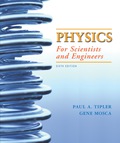
Concept explainers
(a)
The velocity of the particle when its position is
(a)
Answer to Problem 116P
The velocity of particle when its position is
Explanation of Solution
Given:
The acceleration of the particle is given by
The velocity is
Formula used:
Write the expression for the acceleration of the particle.
Here,
Multiply by
Substitute
Substitute,
Simplify above expressinon.
Calculation:
Substitute
Conclusion:
Thus, the velocity of particle when its position is
(b)
The time taken by the particle to travel from
(b)
Answer to Problem 116P
Time taken by the particle to travel from
Explanation of Solution
Given:
The acceleration of the particle is given by
The velocity is
Formula used:
Write the expression for the velocity of the particle.
Further, simplify for
Write the expression for the instantaneous velocity of the particle.
Rearrange the above expression for
Calculation:
Substitute
Substitute
Conclusion:
Thus, time taken by the particle to travel from
Want to see more full solutions like this?
Chapter 2 Solutions
EBK PHYSICS FOR SCIENTISTS AND ENGINEER
- A particle moves along the x axis. Its position is given by the equation x = 2 + 3t 4t2, with x in meters and t in seconds. Determine (a) its position when it changes direction and (b) its velocity when it returns to the position it had at t = 0.arrow_forwardThe acceleration of a particle is defined by the relation a = − 0.8 v, where a is expressed in m/s2 and v in m/s. Knowing that at t = 0 the velocity is 1 m/s, determine the distance the particle will travel before coming to rest.arrow_forwardThe parachutist descends for 130 m in free fall, and then opens the parachute, which slows it down to a speed of 6.5 m/s. For how long does he have to opening the parachute so that the acceleration of the parachute does not exceed 7g? Air resistance is ignored. (The solution is 640 ms)arrow_forward
- A particle has a velocity of v= (3i+5j)m/s and a constant acceleration of a=(-1.5i-4.5j)m/s^2 What is its velocity after 2 seconds? Is it moving faster or slower after 2 seconds?arrow_forwardA juggler throws a bowling pin straight up with an initial speed of 4.3 m/s from an initial height of 1.9 m. How much time elapses until the bowling pin returns to the same initial height?arrow_forwardAt t=0, a train approaching a station begins decelerating from a speed of 96 mi/hr according to the acceleration function a(t)=−1536(1+8t)−3 mi/hr2, where t≥0. How far does the train travel between t=0 and t=0.1? Between t=0.1 and t=0.4?arrow_forward
- A particle moves along the positive x-axis and its position as a function of time is x(t)=(19.9 m/s)t − (1.7 m/s^2)t^2. What is the average velocity in the time interval between 2.3s and 3.7s in m/s?arrow_forwardAn object undergoes acceleration 1.2i+2.4j m/s2 for 4.5 s at which time its velocity is 21i+11j m/s. What was the object’s speed at the beginning of the 4.5 s interval?arrow_forwardA ball is thrown straight upward from ground level with a speed of 22 m/s How much time passes before the ball strikes the ground if we disregard air resistance? 2.2 s 1.4 s 4.5 s 0.7 sarrow_forward
 Principles of Physics: A Calculus-Based TextPhysicsISBN:9781133104261Author:Raymond A. Serway, John W. JewettPublisher:Cengage Learning
Principles of Physics: A Calculus-Based TextPhysicsISBN:9781133104261Author:Raymond A. Serway, John W. JewettPublisher:Cengage Learning
